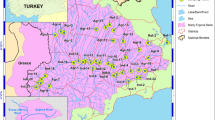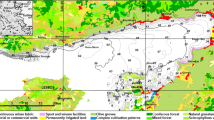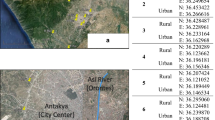Abstract
The objective of this study was to determine the ecological risk created by metal contents of the surface sediments of Atikhisar dam, Çanakkale, NW Turkey. Enrichment factor (EF) and geoaccumulation index (Igeo) were calculated to determine anthropogenic effects. Ecological risk was assessed using the modified potential ecological risk index (mPER), with its levels being evaluated using the modified ecological risk index (mER). Toxic effects were determined using the toxic risk index (TRI). The ecological risk indices were mapped to provide their spatial distributions. Our findings indicate that enrichment was very high for Hg and significant for Pb, Tl, Cd, and As. The following mER pattern was detected: Hg > Cd > TI > As > Pb > Ni > Cr > Co > Zn > Mn > V. Hg and Cd exhibited extremely high and very high ecological risks, respectively, while TI and As had a significant ecological risk, with Pb exerting a medium ecological risk. Hg, Pb, Tl, Cd, As, Cr, Ni, Zn, and Cu were enriched via anthropogenic effects exceeding their natural concentration levels. Due to their high toxic effects, Hg, Cd, Tl, As, and Pb were identified as the very high risk elements. Mining, household wastes, agriculture, and natural mineral deposits were identified as the possible sources of the potential ecological risk.






Similar content being viewed by others
Data availability statement
The datasets generated during and/or analyzed during the current study are available from the corresponding author on reasonable request.
References
Akbulut, M., Odabaşı, S. S., Odabaşı, D. A., & Çelik, E. Ş. (2006). The important freshwaters of the province of Çanakkale and pollution sources. Ege University Journal of Fisheries Aquatic Sciences, 23(1), 9–15.
Akin, B.S., & Kırmızıgül, O. (2017). Heavy metal contamination in surface sediments of Gökçekaya Dam Lake, Eskişehir, Turkey. Environmental Earth Sciences, 76, 402. https://doi.org/10.1007/s12665-017-6744-0
Alghamdi, B., Mannoubi, I., & Zabin, S. (2019). Heavy metals contamination in sediments of Wadi Al-Aqiq water reservoir dam at Al-Baha region, KSA: their identification and assessment. Human and Ecological Risk Assessment: An International Journal, 25(4), 793–818. https://doi.org/10.1080/10807039.2018.1451746
Audry, S., Schafer, J., Blanc, G., & Jouanneau, J. M. (2004). Fifty-year sedimentary record of heavy metal pollution (Cd, Zn, Cu, Pb) in the Lot River reservoirs (France). Environmental Pollution, 132, 413–426. https://doi.org/10.1016/j.envpol.2004.05.025
Başaran, G. (2010). Comparative investigation of heavy metal contracts in Kapulukaya Dam Lake (Kırıkkale) and lower basin water, sediment and aquatic plant samples. Kırıkkale University, Institute of Science, Department of Biology, PhD Thesis.
Bolat, İ., & Kara, Ö. (2017). Plant nutrients: sources, functions, deficiencies and excesses. Bartin Journal of Forestry Faculty, 1(19), 218–228. https://doi.org/10.24011/barofd.251313
Brady, J. P., Ayoko, G. A., Martens, W. N., & Goonetilleke, A. (2015). Development of a hybrid pollution index for heavy metals in marine and estuarine sediments. Environmental Monitoring Assessment, 187(306). https://doi.org/10.1007/s10661-015-4563-x
Çevik, F., Göksu, M. Z., Derici, O. B., & Fındık, Ö. (2009). An assessment of metal pollution in surface sediments of Seyhan dam by using enrichment factor, geoaccumulation index and statistical analyses. Environmental Monitoring and Assessessment, 152, 309–317. https://doi.org/10.1007/s10661-008-0317-3
Chen, Y., Jiang, X., Wang, Y., & Zhuang, D. (2018). Spatial characteristics of heavy metal pollution and the potential ecological risk of a typical mining area: a case study in China. Process Safety and Environmental Protection, 113, 204–219. https://doi.org/10.1016/j.psep.2017.10.008
Çiftçi, M. (2015). Determination of Seydisuyu basin (Eskişehir) water and sediment quality. Anadolu University Graduate School of Science, Master Thesis.
Deng, M., Yang, X., Dai, X., Zhang, Q., Malik, A., & Amir, S. (2020). Heavy metal pollution risk assessments and their transportation in sediment and overlay water for the typical Chinese reservoirs. Ecological Indicators, 112. https://doi.org/10.1016/j.ecolind.2020.106166
Eid, E., Shaltout, K., El-Sheikh, M., et al. (2012). Seasonal courses of nutrients and heavy metals in water, sediment and above- and below-ground Typha domingensis biomass in Lake Burullus. Perspectives for phytoremediation. Flora - Morphol Distrib Funct Ecol Plants, 207, 783–794. https://doi.org/10.1016/j.flora.2012.09.003
Esri. (2021). https://desktop.arcgis.com/en/arcmap/10.3/tools/3d-analyst-toolbox/how-kriging-works.htm
Fural, Ş. (2020). Ecological risk analysis of İkizcetepeler Dam Lake (Balıkesir) sediments. Balıkesir University, Institute of Social Sciences, Department of Geography, PhD Thesis.
Fural, Ş., Kükrer, S., & Cürebal, İ. (2019). Temporal and spatial disturbition of the organic carbon content in sediments of İkizcetepeler Dam Lake (Balıkesir). Turkish Journal of Agriculture - Food Science and Technology, 7(12), 2204-2208. https://doi.org/10.24925/turjaf.v7i12.2204-2208.2966
Fural, Ş., Kükrer, S., & Cürebal, İ. (2020). Geographical information systems based ecological risk analysis of metal accumulation in sediments of İkizcetepeler Dam Lake (Turkey). Ecological Indicators, 119. https://doi.org/10.1016/j.ecolind.2020.106784
Gaudette, H. E., Flight, W. R., Toner, L., & Folger, W. (1974). An inexpensive titration method for the determination of organic carbon in recent sediments. Journal of Sedimentary Petrology, 44, 249–253.
Ghrefat, H., & Yusuf, N. (2006). Assessing Mn, Fe, Cu, Zn, and Cd pollution in bottom sediments of Wadi Al-Arab Dam, Jordan. Chemosphere, 65, 2114–2121. https://doi.org/10.1016/j.chemosphere.2006.06.043
Goher, M. E., Farhat, H. I., Abdo, M. H., & Salem, G. S. (2014). Metal pollution assessment in the surface sediment of Lake Nasser. Egypt. Egyptian Journal of Aquatic Research, 40, 213–224. https://doi.org/10.1016/j.ejar.2014.09.004
Gray, J. E., & Hines, M. E. (2009). Biogeochemical mercury methylation influenced by reservoir eutrophication, Salmon Falls Creek Reservoir, Idaho, USA. Chemical Geology, 258, 157–167. https://doi.org/10.1016/j.chemgeo.2008.09.023
Hahn, J., Opp, C., Evgrafova, A., & Groll, M. (2018). Impacts of dam draining on the mobility of heavy metals and arsenic in water and basin bottom sediments of three studied dams in Germany. Science of The Total Environment, (163), 640–641. https://doi.org/10.1016/j.scitotenv.2018.05.295
Hakanson, L. (1980). An ecological risk index for aquatic pollution control. A sedimentological approach. Water Research, 14(8), 975–1001. https://doi.org/10.1016/0043-1354(80)90143-8
Ilgar, R. (2000). Investigation of Çanakkale strait and environment's ecosystem in terms of geological condition. Istanbul University, Institute of Marine Sciences and Management, Marine Environment Department, PhD Thesis.
Jiang, T., Bravo, G., Skyllberg, U., Bjorn, E., Wang, D., Yan, H., et al. (2018). Influence of dissolved organic matter (DOM) characteristics on dissolved mercury (Hg) species composition in sediment pore water of lakes from southwest China. Water Research, 146, 146–158. https://doi.org/10.1016/j.watres.2018.08.054
Karaca, A., & Turgay, O. C. (2012). Soil Pollution. Journal of Soil Science and Plant Nutrition, (1), 13–19.
Karthikeyan, P., Vennila, G., Nanthakumar, G., & Aswini, M. (2020). Dataset for spatial distribution and pollution indices of heavy metals in the surface sediments of Emerald Lake, Tamil Nadu India. Data in Brief, 28. https://doi.org/10.1016/j.dib.2019.104877
Karbowska, B. (2016). Presence of thallium in the environment: sources of contaminations, distribution and monitoring methods. Environmental Monitoring and Assessment, 188, 640. https://doi.org/10.1007/s10661-016-5647-y
Kaya, H. (2007). Investigation of the pesticide and domestic pollution in Atikhisar reservoir and Sarıçay. Çanakkale Onsekiz Mart University, Graduate School of Natural and Applied Sciences, Department of Fisheries, Master Thesis.
Kaya, H., Erginal, G., Çakır, Ç., Gazioğlu, C., & Erginal, A. (2017). Ecological risk evaluation of sediment core samples, Lake Tortum (Erzurum, NE Turkey) using environmental indices. International Journal of Environment and Geoinformatics, 4, 227–239. https://doi.org/10.30897/ijegeo.348826
Kükrer, S. (2016). Comprehensive risk assessment of heavy metal accumulation in surface sediment of Lake Tortum based on ecological indices. Turkish Journal of Agriculture-Food Science and Technology, 4(12), 1185-1191. https://doi.org/10.24925/turjaf.v4i12.1185-1191.969
Kükrer, S. (2017). Pollution, source, and ecological risk assessment of trace elements in surface sediments of Lake Aktaş, NE Turkey. Human and Ecological Risk Assessment: An International Journal, 23(7), 1629–1644. https://doi.org/10.1080/10807039.2017.1332953
Kükrer, S. (2018). Vertical and horizontal distribution, source identification, ecological and toxic risk assessment of heavy metals in sediments of Lake Aygır, Kars, Turkey. Environmental Forensics, 2(19), 122–133. https://doi.org/10.1080/15275922.2018.1448905
Kükrer, S., Erginal, A. E., Kılıç, Ş., Bay, Ö., Akarsu, T., & Öztura, E. (2020). Ecological risk assessment of surface sediments of Çardak Lagoon along a human disturbance gradient. Environmental Monitoring Assesment, 192. https://doi.org/10.1007/s10661-020-08336-9
Kükrer, S., Erginal, A. E., Şeker, S., & Karabıyıkoğlu, M. (2015). Distribution and environmental risk evaluation of heavy metal in core sediments from Lake Çıldır (NE Turkey). Environmental Monitoring Assessment, 453. https://doi.org/10.1007/s10661-015-4685-1
Laval Martin, D. L. (1985). Spectrophotometric method of controlled pheophytinization for the determination of both chlorophylls and pheophytins in plant extracts. Analytical Biochemistry, 149, 121–129. https://doi.org/10.1016/0003-2697(85)90484-1
Lorenzen, C. (1971). Chlorophyll-degradation products in sediments of Black Sea. Woods Hole Oceanographic Institution Contribution, 28, 426–428.
Luczynskaa, Z., & Kang, M. (2018). Risk assessment of toxic metals in marine sediments from the Arctic Ocean using a modified BCR sequential extraction procedure. Journal of Environmental Science and Health, 53, 278–293.
Ma, L., Xiao, T., Ning, Z., Liu, Y., Chen, H., & Peng, J. (2020). Pollution and health risk assessment of toxic metal(loid)s in soils under different land use in sulphide mineralized areas. Science of The Total Environment, 724. https://doi.org/10.1016/j.scitotenv.2020.138176
MacDonald, D., Ingersoll, C., & Berger, T. (2000). Development and evaluation of consensus-based sediment quality guidelines for freshwater ecosystems. Archives of Environmental Contamination and Toxicology, 39, 20–31. https://doi.org/10.1007/s002440010075
Mishra, S., & Bharagava, R. N. (2016). Toxic and genotoxic effects of hexavalent chromium in environment and its bioremediation strategies. Journal of Environmental Science and Health, Part C, 34, 1. https://doi.org/10.1080/10590501.2015.1096883
Müller, G. (1969). Index of geo-accumulation in sediments of the Rhine river. Geochemical Journal, 2, 108–118.
Naz, A., Chowdhury, A., Kumar, B. M., & Gupta, S. K. (2016). Metal pollution in water environment and the associated human health risk from drinking water: a case study of Sukinda chromite mine. India, Human and Ecological Risk Assessment: An International Journal, 22(7), 1433–1455. https://doi.org/10.1080/10807039.2016.1185355
Ordiales, E., Esbrí, J., Covelli, S., Berdonces, M., Higueras, P., & Loredo, J. (2015). Heavy metal contamination in sediments of an artificial reservoir impacted by long-term mining activity in the Almadén mercury district (Spain). Environmental Science and Pollution Research, 23(7). https://doi.org/10.1007/s11356-015-4770-6
Öztürk, B., & Erginal, A. E. (2001). Geomorphology of Saricay Basin. Turkish Geographical Journal, 36, 49–86.
Peraza, J., Anda, J., Farias, F., & Rode, M. (2015). Assesment of heavy metals in sediments of Aguamilpa Dam, Mexico. Environmental Monitoring and Assessment, 3(187), 4359–4370. https://doi.org/10.1007/s10661-015-4359-z
Pinedo-Hernández, J., Marrugo-Negrete, J., & Díez, S. (2015). Speciation and bioavailability of mercury in sediments impacted by gold mining in Colombia. Chemosphere, 119, 1289–1295. https://doi.org/10.1016/j.chemosphere.2014.09.044
Schlichting, E., & Blume, H. (1966). Bodenkundliches praktikum. Verlag Paul.
Sey, E., & Belford, E. (2019). Levels of heavy metal and contamination statüs of a decommissioned Tailing Dam in Ghana. Environmental Quality, 35, 33–50. https://doi.org/10.6092/issn.2281-4485/9060
Song, J., Liu, Q., & Sheng, Y. (2019). Distribution and risk assessment of trace metals in riverine surface sediments in gold mining area. Environmental Monitoring and Assessment, 191(3), 191. https://doi.org/10.1007/s10661-019-7311-9
Sojka, M., Jaskuła, J., & Siepak, M. (2019). Heavy metals in bottom sediments of reservoirs in the lowland area of Western Poland: concentrations, distribution, sources and ecological risk. Water, 11(56). https://doi.org/10.3390/w11010056
Sutherland, R. A. (2000). Bed sediment-associated trace metals in an urban stream, Oahu, Hawaii. Environmental Geology, 6(39), 611–627. https://doi.org/10.1007/s002540050473
Tecra Tech Inc. (2005). Guadalupe River Watershed Reservoir Sediment Sample. Tetra Tech Inc.
Tomlinson, D., Wilson, J., Harris, C., & Jeffrey, D. (1980). Problems in the assessment of heavy-metal levels in estuaries and the formation of a pollution index. Helgolander Meeresunters, 566–575.
Toptepe, E. (2011). The sustainability analysis of the Atikhisar Dam basin. Çanakkale Onsekiz Mart University, Institute of Social Sciences, Department of Geography, Master Thesis.
Tytła, M., & Kostecki, M. (2019). Ecological risk assessment of metals and metalloid in bottom sediments of water reservoir located in the key anthropogenic “hot spot” area (Poland). Environmental Earth Sciences, 179, 2–17. https://doi.org/10.1007/s12665-019-8146-y
Ustaoğlu, F., Tepe, Y., & Aydın, H. (2020). Heavy metals in sediments of two nearby streams from Southeastern Black Sea coast: contamination and ecological risk assessment. Environmental Forensics, 21(2), 145–156. https://doi.org/10.1080/15275922.2020.1728433
Vrhovnik, P., Šmuc, N. R., Dolenec, T., Serafimovski, T., & Dolenec, M. (2013). An evaluation of trace metal distribution and environmental risk in sediments from the Lake Kalimanci (FYR Macedonia). Environmental Earth Sciences, 70(2), 761–775. https://doi.org/10.1007/s12665-012-2166-1
Wang, C., Liu, S., Zhao, Q., Deng, L., & Dong, S. (2012). Spatial variation and contamination assessment of heavy metals in sediments in the Manwan Reservoir, Lancang River. Ecotoxicology and Environmental Safety, 82, 32–39. https://doi.org/10.1016/j.ecoenv.2012.05.006
Xu, M., Sun, W., & Wang, R. (2019). Spatial distribution and ecological risk assessment of potentially harmful trace elements in surface sediments from Lake Dali, North China. Water Research, 11, 2554. https://doi.org/10.3390/w11122544
Yang, H., Turner, S., & Rose, N. L. (2016). Mercury pollution in the lake sediments and catchment soils of anthropogenically-disturbed sites across England. Environmental Pollution, 219, 1092–1101. https://doi.org/10.1016/j.envpol.2016.09.012
Zhang, G., Bai, J., Zhao, Q., et al. (2016). Heavy metals in wetland soils along a wetland-forming chrono sequence in the Yellow River Delta of China: levels, sources and toxic risks. Ecological Indicators, 69, 331–339.
Zhou, Q., Yang, N., Li, Y., Ren, B., Ding, X., Bian, H., et al. (2020). Total concentrations and sources of heavy metal pollution in global river and lake water bodies from 1972 to 2017. Global Ecology and Conservation, 22, 1–11. https://doi.org/10.1016/j.gecco.2020.e00925
Acknowledgements
This study was carried out with the financial support of Balıkesir University, Scientific Research Projects Unit (Project number: SB 2019-030). We would like to thank Professor Dr. A. Evren Erginal for supervising the project stage of the study, Furkan Inan for his help in the field work, and Mr. Graham Lee for proof-reading the text.
Author information
Authors and Affiliations
Corresponding author
Additional information
Publisher's Note
Springer Nature remains neutral with regard to jurisdictional claims in published maps and institutional affiliations.
Rights and permissions
About this article
Cite this article
Fural, Ş., Kükrer, S., Cürebal, İ. et al. Spatial distribution, environmental risk assessment, and source identification of potentially toxic metals in Atikhisar dam, Turkey. Environ Monit Assess 193, 268 (2021). https://doi.org/10.1007/s10661-021-09062-6
Received:
Accepted:
Published:
DOI: https://doi.org/10.1007/s10661-021-09062-6




